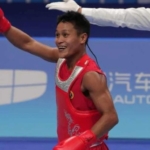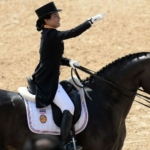
In the kaleidoscope of sports, where every number tells a story of dedication and dreams, a single photograph has unwittingly woven a narrative steeped in history’s shadows. This image, capturing two Chinese female athletes, has emerged as an unlikely catalyst, breathing life into discussions about the hushed pages of the Tiananmen Square massacre, and, in the process, inviting the scrutiny of China’s relentless social media censorship.
The Controversy Explained
At its core, the controversy revolves around the seemingly innocuous race numbers of Lin Yuwei and Wu Yanni, unremarkable digits ’64.’ But for those versed in the annals of China’s history, these numbers transcend mere numerals; they become a somber reference to a pivotal date – June 4th, 1989, when the tumultuous echoes of tragedy resounded through Tiananmen Square.
This is a date etched into the collective memory, marking the brutal clash between Chinese troops and pro-democracy protesters. The true toll of that day remains shrouded in mystery, with estimates by human rights organizations ranging from several hundred to several thousand lives extinguished.
Lin Yuwei and Wu Yanni
Now, let’s shift our gaze to the heart of this enigma, an innocent photograph capturing a poignant moment shared by Lin Yuwei and Wu Yanni, moments after Lin clinched the coveted gold in a triumphant 100m hurdles race at the Asian Games. In this frame, the two athletes stand intertwined, their lane numbers forming an accidental symbol – ’64,’ a subtle nod to the historical tragedy.
The resonance of this image was swift, with Chinese netizens flocking to Weibo, the nation’s digital agora, to celebrate Ms. Lin’s victory. Yet, as swiftly as these posts appeared, they vanished, leaving behind a trail of nondescript grey squares. In a digital sleight of hand, these posts, along with the evocative photograph, were erased – a digital version of forbidden speech rendered mute.
However, not all traces of this image were expunged. Like whispers in the wind, the photograph lingers in select corners of the internet, etched in Chinese news articles that dare to tread lightly on this delicate terrain.
Keep Reading
This incident is more than a fleeting controversy; it serves as a microcosm of a broader landscape dominated by censorship and the suppression of conversations surrounding Tiananmen Square. In China, speaking of this historical chapter is a high-wire act – authorities meticulously erase traces of related content from the digital realm. As a result, younger generations of Chinese grow up shielded from the haunting history of Tiananmen Square, ensnared in a carefully crafted narrative.
And now, as the Asian Games unfurl in Hangzhou, where China’s athletes amass a treasury of medals, a seemingly innocuous image – two digits entwined – rekindles a complex dialogue. It underscores the extent to which censorship is enforced, even in the most subtle of references, leading to the suppression of dialogue and dissent.
In this unexpected twist of fate, a simple photograph, composed of mere numbers, echoes a profound discussion. It serves as a reminder that history’s weight is carried not only in textbooks but in the present, where digital imagery becomes a canvas for a narrative both whispered and shouted, shaping the destiny of nations and the world’s perception.


























